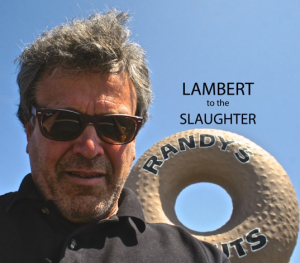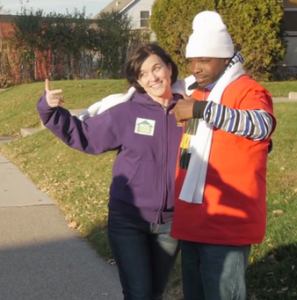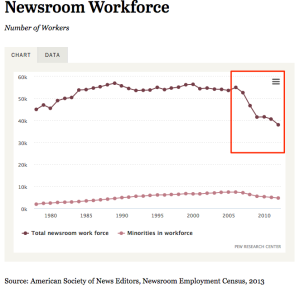 [REVISED] If you’ve caught wind of KSTP-TV’s fiasco with Minneapolis Mayor Betsy Hodges‘ “gang signs” photo and wondered, “How the [bleep] does something that stupid, crass and cynical even get on the air?”, let me try to help.
[REVISED] If you’ve caught wind of KSTP-TV’s fiasco with Minneapolis Mayor Betsy Hodges‘ “gang signs” photo and wondered, “How the [bleep] does something that stupid, crass and cynical even get on the air?”, let me try to help.
For some, the bottom line is simply that (veteran) reporter Jay Kolls all but played paid messenger for a cop shop hit job on a Mayor (and a police chief) the rank and file don’t much care for. (To which I usually say, “Beware a Mayor and Chief that crowd actually likes.”) But worse, for Kolls and KSTP, who are enduring a coast-to-coast savaging for both stupidity and racism, Kolls’ newsroom bosses consented to being played as badly as we was. To the point that they were so credulous they didn’t even bother with the minimum context of noting in their broadcast piece that the “gangbanger” (as Kolls has taken to calling the kid in question in a ridiculously defensive Twitter dialogue) was himself, at the time of the photo … participating in the get-out-the-vote effort mentioned only in passing.
I mean, this story is so nakedly and thoroughly targeted at a key demographic for local TV news you practically choke on it. And by that I mean this: The only viewers who were going to swallow this story — as Kolls and KSTP presented it — are fearful whites with little or no personal interaction with blacks or other minorities. People who almost never counter-balance the “news” they get on TV with any other stream of information, other than maybe an e-mail from an equally fearful friend or relative.
With the audience for local TV news was shrinking nearly as fast as it has been for daily newspapers (until a modest uptick in 2013) the core that remains is both older and (I strongly suspect) less socially sophisticated — i.e. more isolated from “criminal elements” than even 20 years ago. Where savvier news consumers have long since stopped rolling their eyes at the cliched/treadworn “if it bleeds it leads” news segments and turned off the local news altogether in favor of the internet, the crowd that remains faithful to local TV continues to be riveted by the relentless narrative of hardened thugs gunning down each other and therefore, soon to be blasting their way through the front doors of those same terrified viewers, never mind that their doors are in Maple Grove, Big Lake, Victoria, Edina and St. Cloud.
It was to that core local news crowd, primarily white, aged and out of step with the realities of modern urban America that Kolls and KSTP were appealing, and why they look like such pawns and fools today. (According to Pew research 54% of local TV’s news audience is over age 50. Although it could be worse. The over-50 audiences for Bill O’Reilly and Sean Hannity clock in at 64% and 66% respectively.)
Now, having spent a bit of time in the Hubbard Broadcasting empire, I’m not going to go call anyone over there a racist. Although how the racist overtones of this story didn’t head butt someone in the KSTP newsroom I fail to imagine.
What I will say is that the Hubbards themselves, having always been wealthy, are in fact “different”. They never have to deal with shareholders ranting on the phone about public face-plants like this bit of buffoonery or other embarrassments that might crater the stock price. Instead, you have a family operation that long, long ago got comfortable with doing a very public business in their own private way. A family long accustomed to seeing the world as they choose to see it reiterated on their air. in that context a story handed them by the cops (law and order) directly suggesting that the new Mayor (liberal and female) is sympathetic to thugs (young blacks) fits with the acceptable company narrative. Put another way, it appeals to viewers KSTP wants to appeal to.
More to the point, when you work for “the family”, especially in any kind of on-air or management position, you don’t have to wait for a call or e-mail telling you what to say and what not to say. If, for example, you’re a weatherman, you understand implicitly that human-caused climate change is a hoax and the sort of thing you never mention on air. It becomes a second nature. As part of the “team”, you absorb the essence of the family’s perspective like a kind of survival instinct. What the family prefers or doesn’t object to becomes what you deliver on air, if you’d like to hang around for a while.
That said, this “gang signs” thing Kolls put up is still beyond belief.
Jay, who I covered back in the ’90s and once brawled with over a story I’ve now forgotten (we later had drinks and smoothed things over) is on a “second chance” run with the Hubbards, having been “let go” and hired back at a time when older, white males are not exactly prime consideration for reporting jobs. The Hubbards are good about that kind of thing, perhaps because an older guy (or gal) given a second chance is uniquely grateful and more likely to deliver the type of news product most preferred by the forces upstairs.
Still … the astonishing things to me in this episode are that Kolls allowed himself to be tooled so flagrantly by the cops and then that this thing got past an editor. I mean in what universe does a professional news director in 2014 not look at this mess and say, “Uh, I gotta tell ya Jay, it looks to me like she’s just pointing at the guy. And remind me, what’s she doing with him, anyway? What? He was part of the vote thing, too! Well shit, we better get that in there somewhere.”
Pro news people I’ve known wouldn’t have touched this story if only on the grounds that they could smell a reporter getting tooled by the cops and that if the ran it they’d look so clueless and chumpy, to their professional peers.
And while I’m at it … how does a new director not say to her reporter, “For crissakes, how many dog whistles can one guy blow in the same story?”
So do I think Stanley Hubbard is happy about the way this thing is playing out? No, I do not. If no one had noticed or said anything, he wouldn’t have cared. (Hell, he probably wouldn’t have noticed). But now that his station (which is run by his son Rob) is a national laughing stock, I’m guessing he’s having a bad day which means a few of his underlings are having a day that’s even worse.
Not that the first crisis management move won’t be to ignore the firestorm as long as possible and hope it fades away, obliterated by, you know, police tape video of a gang-banger shoot-out or something.
 The 120,000 Minnesota small donors who heroically pulled together to pool an $18 million donation during yesterday’s Give MN’s “Give to the Max Day” should be very proud of themselves.
The 120,000 Minnesota small donors who heroically pulled together to pool an $18 million donation during yesterday’s Give MN’s “Give to the Max Day” should be very proud of themselves.
 I can’t see into the heads and hearts of KSTP-TV reporter Jay Koll’s and his editors, so I can’t tell you if
I can’t see into the heads and hearts of KSTP-TV reporter Jay Koll’s and his editors, so I can’t tell you if  The Newsroom’s First Rule of Motion has always been a force, but it has become much more of a force since news organizations starting losing lots of money, and
The Newsroom’s First Rule of Motion has always been a force, but it has become much more of a force since news organizations starting losing lots of money, and 